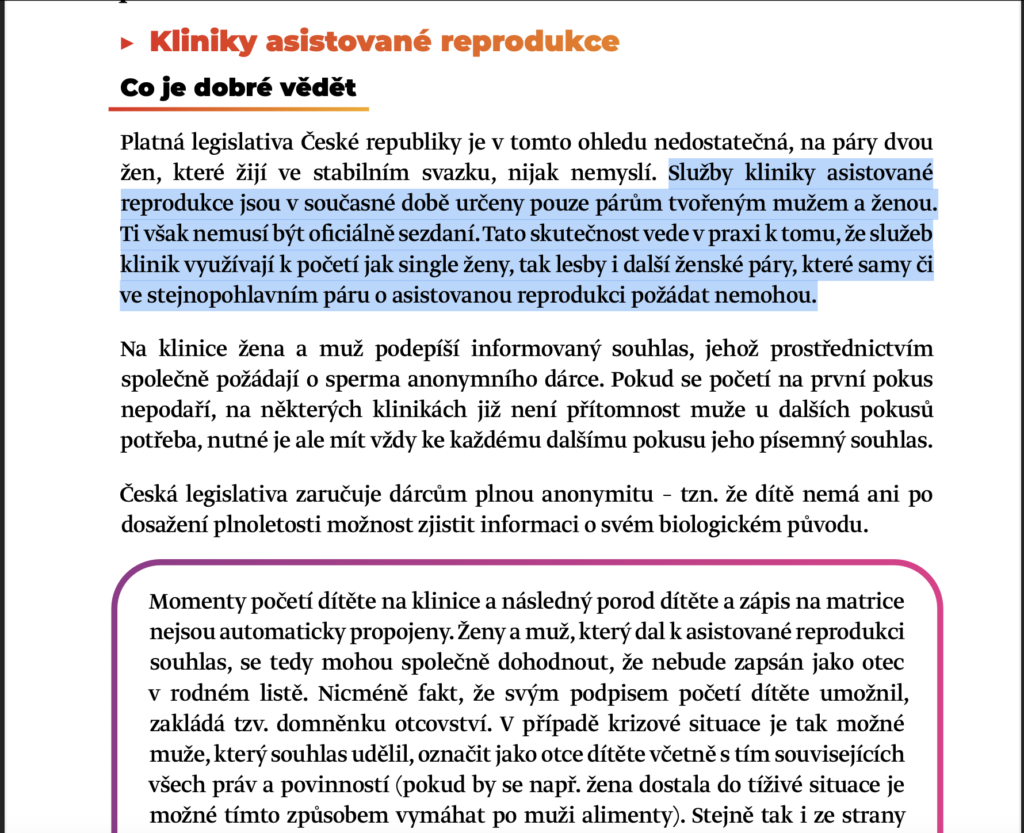Starring Chaos
The amendment, which was approved by the Chamber of Deputies last week, has brought a lot of chaos. For example, for people living in a registered partnership. Thanks to the lack of transitional provisions, they will not be able to enter into the new institution of “partnership” without dissolving the existing registered partnership. But if only that. The decision of the MPs and MEPs has produced much more substantial “details”.
In Article I, point 1, a new paragraph 2 containing a definition of the new legal institute of partnership is inserted into the existing provision of Article 655 of the Civil Code containing the definition of marriage, and moves the institute regulating the cohabitation of two persons of the same sex from a special law (the law on registered partnership) to the private law code, Part Two, which contains the entire family law.
The amendment therefore does not reflect this change in the title of the specific provision. It is still entitled ‘Definition of marriage’. It is therefore most appropriate that the change in the wording of the paragraph should be reflected in the title of the provision: “Definition of marriage and civil partnership.”
With regard to the manner and order of the entire Civil Code, it would obviously be preferable to separate the institution of partnership into a separate title with a separate title, so that marriage and partnership are regulated separately, as two distinct legal institutions.
At the same time, the very definition of the institution of partnership is technically unfortunate. It reads:
House Bill 241 in the approved wording
“(2) A partnership is a permanent union of two people of the same sex, which is entered into in the same way as marriage. Unless otherwise provided by law or other legislation, the provisions on marriage, rights and obligations of spouses, widows and widowers shall apply mutatis mutandis to a partnership and the rights and obligations of partners.”
The definition is therefore only clear if we know that it is a permanent union of two people of the same sex. The institution of partnership is thus open only to persons of the same sex, not to persons of different sexes. Partners are subject to all the rights and obligations of spouses, unless the law expressly says otherwise.
A systematic interpretation leads to the conclusion that the very definition of a different legal institution is included as a qualified subcategory of the institution of marriage. At the same time, however, it does not provide a clear answer to the extent to which the provision of the second sentence of the identical Article 655(1) applies to this institution: “The main purpose of marriage is the establishment of a family, the proper upbringing of children and mutual support and assistance.”
In view of the content of the institution as defined, the application cannot be excluded. See Article I(2), which regulates the wording of Article 778 of the Civil Code (“If a child conceived by artificial insemination is born to an unmarried woman or to a woman in a civil partnership, the man who gave his consent to the artificial insemination shall be presumed to be the father of the child; …”). It thus extends the presumption of paternity to the case where a child is born to a woman in a civil partnership. However, it allows the presumption of paternity to be eliminated and the father to be removed from the child in conjunction with other legal provisions.
Thus, it can be said that one of the purposes of the partnership is to establish a family. Although the amendment does not explicitly say so, it implicitly includes that purpose. It is certainly not a mistake. Undoubtedly, it is an intention to be missed by less vigilant legislators.
The amendment includes the right to a child
Yes. According to the new wording, the state gives the right to the child regardless of biological reality. In particular, this is illustrated very precisely by the above-mentioned example of Article I(2) of the presumption of paternity in conjunction with another “innovation”, namely the possibility of adopting the child of a spouse or partner, newly enshrined in Article I(3) of the amending provision of Article 800(1) of the Civil Code, where the following wording is added to the end of the sentence regulating the forms of adoption by spouses: “, or a partner may also become an adoptive parent if the other partner is the parent of the child”.
Although the above extension of the presumption of paternity gives the impression that the legislators are thinking about the father of the child (in the interest of the child), the practice and continuity of the other regulations is nil.
Artificial insemination and the whole process is regulated in the Specific Health Services Act. The prerequisite under the Act, specifically the provisions of Section 6(1), is an infertile couple consisting of a man and a woman, where the woman must not be more than 49 years of age. Although infertility is a prerequisite, infertility of the couple is not a necessary condition: “Artificial insemination may be performed on a woman of childbearing age, provided that her age is not more than 49 years, on the basis of a written request from a woman and a man who intend to undergo this health service together (hereinafter referred to as the ‘infertile couple’). The request from the infertile couple requesting artificial insemination must not be more than 6 months old; it is part of the medical records kept on the woman.”
Thus, the law does not explicitly exclude a fertile couple from the process. The fact that the whole process is overwhelmingly funded by health insurance as a medical treatment leaves some applicants completely cold. And we’re not done yet. A child conceived through artificial insemination is born after nine months. This involves the process of registration in the civil registry, specifically the birth register. The man’s consent to assisted reproduction and the resulting presumption of paternity is not at all linked to the entry in the birth register. Thus, the birth mother, one of the lesbians, has the possibility to indicate the father of the child (the man who gave consent or the biological father), but she does not have to do so (this is explicitly allowed by the provisions of Section 16(2) – birth of a child outside marriage whose father is unknown).
Lesbian couples take advantage of this, which is why the child has only one parent under the law, namely the mother who gave birth to the child. However, the child also has a second biological parent, whom the mother has chosen to deny the child. This is where the amendment and its new Article 1(3) comes in, allowing the adoption of a partner’s child. This ethically very problematic process legalises the desires of adults, but no one addresses the child’s right to a father. Until now, this process has been used, but it has not provided a legal framework, because if the other partner wanted to adopt the child, the woman who gave birth to the child would have to give up her parental rights. This reflects biological reality and does not reward an ethically problematic process.
Yes, one could argue that heterosexual women are also guilty of concealing the father in their child’s life, which is undoubtedly true. On the other hand, I have not seen these women seeking a change in the legal system that would bend their ethically problematic practice in any way.
For example, the whole process is explicitly recommended in a handbook aptly titled She and She Plan a Family or How to Meet Happiness by Prague Pride, the founding organization of the We Are Fair initiative:

It is hard to avoid the feeling that the child is becoming an object of adult desires whose rights are being resigned to by the state.
Children: a product of fabrication
Article I(3) above also has major implications for same-sex couples composed of men. Some of them, a very tiny minority, as evidenced by data from public registries, for example, in the Netherlands, only 1% of gay couples have a child at home (Chen, S., & van Ours, J. C., “Symbolism Matters: The Effect of Same-Sex Marriage Legalization on Partnership Stability,” Journal of Economic Behavior & Organization 178 (2020): 44-58). Czech research has reached a similar conclusion, but it was not conducted with the same relevant sample and only looked at preferences. The research states that only 8% of gay men desire to have a child (Maříková, H., M. Vohlídalová. 2019. Barriers versus preferred forms of parenthood in the non-heterosexual population. Social Policy Forum 13 (6): 20-26).
While orphanages are full of children, legally free children of newborn age are at an absolute minimum. Conversely, legally free children are more numerous only when they are older and often with disabilities. This is also why a large part of this minority of the minority uses surrogacy, as it is the only way to have children of their own. At the same time, they do so mainly abroad, where there is sufficient legal certainty for the ordering party that the whole ordering of the child will succeed and the child, who becomes a contracted commodity, will actually be taken away.
The surrogacy process is legal in several countries around the world. For a gay couple, this means that they hire an egg donor, then provide sperm and the reproductive clinic injects the resulting embryo into the surrogate. The surrogate mother agrees to hand over the child to the commissioning parents after birth. This is a very ethically problematic process, as the child becomes the object of the contract and the woman becomes the carrier.
Czech gay couples most often choose some US states where surrogacy is legal and there is the possibility of enforcing the surrogate’s contract. Until now, it has been possible to recognise foreign court decisions concluding the surrogacy process by way of a determination of parentage within the meaning of Section 55 of the Private International Law Act. The amendment passed by the Chamber of Deputies will now allow for the full legal recognition of a court decision concluding the surrogacy process in the form of an adoption decision or in any other way, as the condition that a foreign adoption decision is recognised by a Czech court in the Czech Republic on condition that the adoption is possible under Czech substantive law will be removed. Therefore, the gay couple will achieve the legal effect of the foreign decision for at least one of the persons and subsequently the other partner will adopt the children according to Article I, point 3 of the amendment without the children losing the original registered parent.
Two parents of the same sex will be registered on the birth certificate (model No. 23) with the parent and parent boxes under the implementing decree No. 174/2023 Coll. on the amendment to the Civil Registry Act, which Deputy Prime Minister Rakušan pushed through last year for the foreign recognition of parenthood. According to behind the scenes, he justified the wording of the new decree and the new model to his coalition partners with raised eyebrows, pointing to transgender people who change their official gender so that their children would have a birth certificate that respects their new official gender. Despite our repeated warnings and criticism in the form of articles and happenings, the coalition partners believed the Deputy Prime Minister and will now reap what their own Deputy Prime Minister sowed with their approval. At the same time, it is truly ironic that the chief fighter against surrogacy in the Czech Republic, law professor Helena Válková, is the co-sponsor of this bill.
Now it is the Senate’s turn to correct this approved travesty. And unlike the Chamber of Deputies, it could focus on the rights of children, not just the desires of adults.
